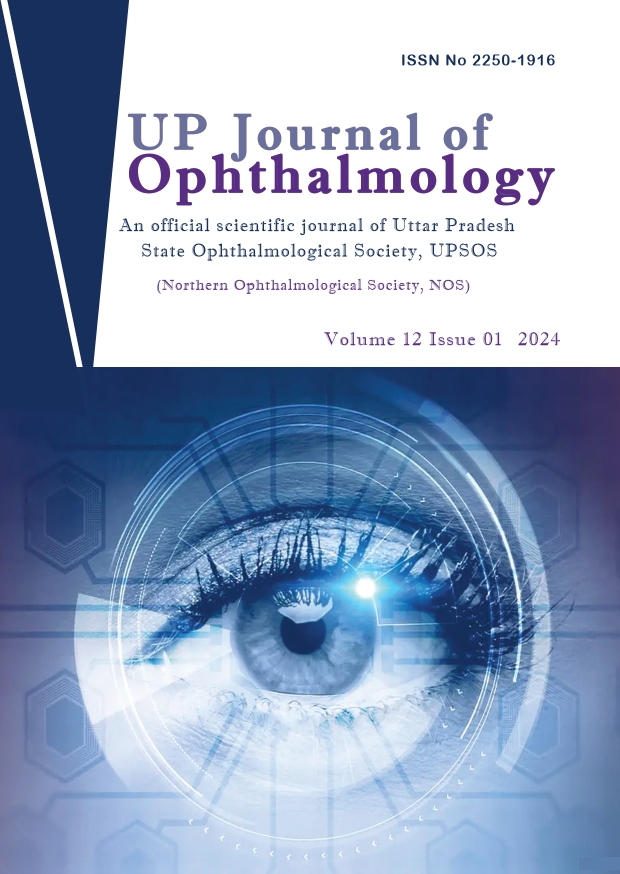Linezolid Optic Neuropathy
Downloads
Published
DOI:
https://doi.org/10.56692/upjo.2024120106Keywords:
Linezolid, Optic neuropathy, Scotoma.Dimensions Badge
Issue
Section
License
Copyright (c) 2024 Radhika Gupta, Richa Chauhan, Reena Sharma, Narendra Gupta, Mafat Lal, Ravi Ranjan

This work is licensed under a Creative Commons Attribution-NonCommercial-ShareAlike 4.0 International License.
© Author, Open Access. This article is licensed under a CC Attribution 4.0 License, which permits use, sharing, adaptation, distribution and reproduction in any medium or format, as long as you give appropriate credit to the original author(s) and the source, provide a link to the Creative Commons licence, and indicate if changes were made. The images or other third party material in this article are included in the article’s Creative Commons licence, unless indicated otherwise in a credit line to the material. If material is not included in the article’s Creative Commons licence and your intended use is not permitted by statutory regulation or exceeds the permitted use, you will need to obtain permission directly from the copyright holder. To view a copy of this licence, visit https://creativecommons.org/licenses/byncsa/4.0/.
Various systemic antimicrobials have been known to cause ocular adverse effects. Linezolid has been shown to be effective in treating multidrug-resistant tuberculosis. Though, long-term treatment is discontinued by the related side effects, such as ocular and peripheral neuropathy. In a developing country like India, where there is increasing burden of multidrug-resistant tuberculosis, ophthalmologists and physicians should be aware of linezolid induced optic neuropathy so that monitoring of visual functions in patients on long-term linezolid treatment can be done to avoid serious neurological consequences.Abstract
How to Cite
Downloads
Similar Articles
- Shefali Pandey, Shalini Mohan, Namrata Patel, A Rare Case of Leber’s Hereditary Optic Neuropathy , UP Journal of Ophthalmology: Vol. 13 No. 01 (2025): UP Journal of Ophthalmology
- Shivani Chaturvedi, Sandeep Saxena, Optic Nerve Head Melanocytoma: The Black Sentinel , UP Journal of Ophthalmology: Vol. 13 No. 01 (2025): UP Journal of Ophthalmology
- Sakshi Kumar, Renu P Rajan, Naresh Babu Kannan, Kim Ramasamy, Rarus Congenitus Anomalia- A Rare Congenital Anomaly of Optic Nerve Aplasia , UP Journal of Ophthalmology: Vol. 8 No. 03 (2020): UP JOURNAL OF OPHTHALMOLOGY
- Priti Yadav, Neelima Mehrotra, Kunwar Gaurav Singh, Manu Saini, Duloxetine-induced Optic Neuropathy: A Rare Case Report , UP Journal of Ophthalmology: Vol. 13 No. 01 (2025): UP Journal of Ophthalmology
- Richa Gupta, Role of OCT in Glaucoma , UP Journal of Ophthalmology: Vol. 4 No. 01 (2016): UP JOURNAL OF OPHTHALMOLOGY
- Shalini Mohan, Anchal Tripathi, Lubna Ahmed, Shweta Sharma, Ditsha Datta, Use of OCT for Glaucoma Specialists , UP Journal of Ophthalmology: Vol. 13 No. 01 (2025): UP Journal of Ophthalmology
- Shalini Mohan, Jayati Pandey, Anchal Tripathi, Ashok K. Verma, Optic Nerve Sheath Diameter in Glaucoma Patients and its Correlation with Intraocular Pressure , UP Journal of Ophthalmology: Vol. 10 No. 01 (2022): UP JOURNAL OF OPHTHALMOLOGY
- U. S. Tiwari, Lessons Learned from Landmark Studies in Glaucoma , UP Journal of Ophthalmology: Vol. 11 No. 03 (2023): UP JOURNAL OF OPHTHALMOLOGY
- Charu Agrawal, Setting Target IOP in Glaucoma , UP Journal of Ophthalmology: Vol. 4 No. 01 (2016): UP JOURNAL OF OPHTHALMOLOGY
- Tanuja Kate, Micropulse Trans-Scleral Cyclophotocoagulation: A new Innovative Technology in Glaucoma Management , UP Journal of Ophthalmology: Vol. 8 No. 02 (2020): UP JOURNAL OF OPHTHALMOLOGY
You may also start an advanced similarity search for this article.







